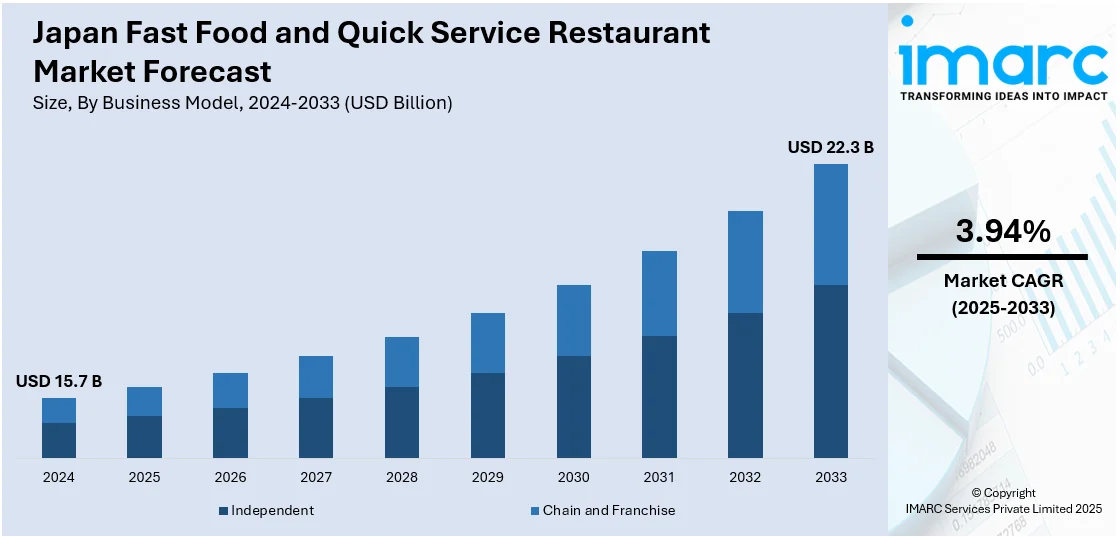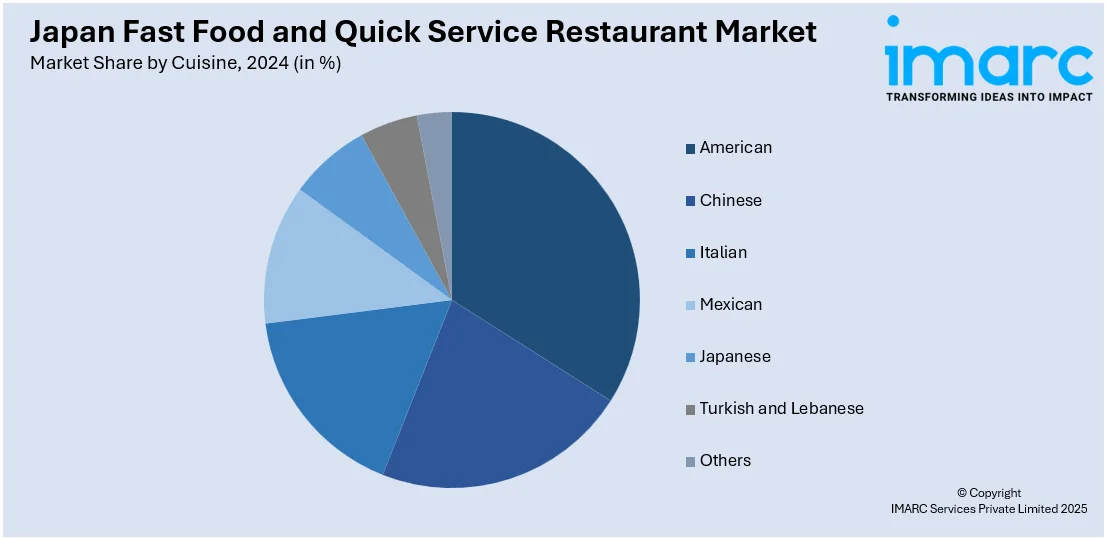
Japan Fast Food and Quick Service Restaurant Market Size, Share, Trends and Forecast by Business Model, Cuisine, Product Type, Service Type, and Region, 2025-2033
Japan Fast Food and Quick Service Restaurant Market Overview:
The Japan fast food and quick service restaurant market size reached USD 15.7 Billion in 2024. Looking forward, IMARC Group expects the market to reach USD 22.3 Billion by 2033, exhibiting a growth rate (CAGR) of 3.94% during 2025-2033. The market is driven by busy lifestyles, high urbanization, and demand for convenience. Innovations in automation, localized menus, and digital ordering are contributing positively to the market growth across the country.
|
Report Attribute
|
Key Statistics
|
|---|---|
|
Base Year
|
2024
|
|
Forecast Years
|
2025-2033
|
|
Historical Years
|
2019-2024
|
| Market Size in 2024 | USD 15.7 Billion |
| Market Forecast in 2033 | USD 22.3 Billion |
| Market Growth Rate 2025-2033 | 3.94% |
Japan Fast Food and Quick Service Restaurant Market Trends:
Adoption of Automation and Robotics
Automation and robotics are playing a growing role in reshaping Japan’s fast food and quick service restaurant sector. With the country facing a chronic labor shortage and rising operational costs, many QSRs are turning to robotic systems for cooking, order taking, cleaning, and even table service. This trend is contributing to increased efficiency, consistency in service, and cost savings, supporting overall Japan fast food and quick service restaurant market share. Robotics not only help offset workforce constraints but also align with Japan’s tech-savvy consumer expectations. From burger-flipping robots to AI-enabled kiosks, automation is becoming a key part of modern QSR operations. For instance, in March 2025, Circus SE announced its partnership with Mangal to launch the world’s first fully autonomous restaurant chain, starting with 500 CA-1 robots in Germany by fall 2025. The expansion plans include up to 2,400 locations across Europe, Turkey, and Japan, transforming quick-service dining with advanced AI and robotics technology. Smaller outlets and high-traffic chains in particular are benefitting from these technologies. As innovation continues and costs of adoption decrease, robotics are expected to play an even more significant role in the Japan fast food and quick service restaurant market outlook.

Increased Franchise Model Penetration
Franchise-based expansion is gaining momentum in Japan’s fast food and QSR industry as both domestic and international brands seek efficient ways to scale. The franchise model allows rapid geographic penetration with lower capital risk, making it an attractive route for growth in urban centers and emerging suburban areas. Established QSR players are offering flexible franchise terms, brand training, and technology integration to attract new investors. This approach enables consistent brand experience while tapping into local market knowledge. The model also supports the spread of niche and specialty cuisines, broadening consumer choice beyond traditional fast food. With rising consumer demand for convenience, speed, and brand familiarity, franchise networks are reinforcing brand presence and driving competitiveness. For instance, in February 2025, CoCo Bubble Tea announced its plans to launch its first single-store franchise opportunities in Japan, driven by the growing demand for bubble tea. The brand will enhance training, operational support, and supply channels tailored for local partners, offering a proven model and competitive terms, along with collaborations with renowned Japanese brands. This expansion strategy is playing a crucial role in improving accessibility and service delivery, contributing significantly to Japan fast food and quick service restaurant market growth.
Japan Fast Food and Quick Service Restaurant Market Segmentation:
IMARC Group provides an analysis of the key trends in each segment of the market, along with forecasts at the regional level for 2025-2033. Our report has categorized the market based on business model, cuisine, product type, and service type.
Business Model Insights:
- Independent
- Chain and Franchise
The report has provided a detailed breakup and analysis of the market based on the business model. This includes independent and chain and franchise.
Cuisine Insights:

- American
- Chinese
- Italian
- Mexican
- Japanese
- Turkish and Lebanese
- Others
A detailed breakup and analysis of the market based on the cuisine have also been provided in the report. This includes American, Chinese, Italian, Mexican, Japanese, Turkish and Lebanese, and others.
Product Type Insights:
- Burgers and Sandwiches
- Pizzas and Pastas
- Drinks and Desserts
- Chicken and Seafood
- Others
A detailed breakup and analysis of the market based on the product type have also been provided in the report. This includes burgers and sandwiches, pizzas and pastas, drinks and desserts, chicken and seafood, and others.
Service Type Insights:
- Online Service
- Offline Service
A detailed breakup and analysis of the market based on the service type have also been provided in the report. This includes online service and offline service.
Regional Insights:
- Kanto Region
- Kansai/Kinki Region
- Central/Chubu Region
- Kyushu-Okinawa Region
- Tohoku Region
- Chugoku Region
- Hokkaido Region
- Shikoku Region
The report has also provided a comprehensive analysis of all the major regional markets, which include Kanto Region, Kansai/Kinki Region, Central/Chubu Region, Kyushu-Okinawa Region, Tohoku Region, Chugoku Region, Hokkaido Region, and Shikoku Region.
Competitive Landscape:
The market research report has also provided a comprehensive analysis of the competitive landscape. Competitive analysis such as market structure, key player positioning, top winning strategies, competitive dashboard, and company evaluation quadrant has been covered in the report. Also, detailed profiles of all major companies have been provided.
Japan Fast Food and Quick Service Restaurant Market News:
- In April 2025, McDonald’s Japan, in collaboration with TBWA\HAKUHODO, announced the launch of "Fandom Feast," integrating fandom culture with social commerce. Partnering with girl group XG, the campaign enhanced fan engagement through live events and exclusive menu items, solidifying McDonald's role in Japan's evolving social commerce landscape. Sales surged, reflecting the initiative's success.
- In November 2024, Burger King Japan announced the launch of the exclusive "KYOTO Whopper. Crafted in collaboration with Hachidaime Gihey, this unique burger features a special rice patty, flame-grilled beef, and a Japanese-style ginger sauce, offering a fusion of traditional flavors and expert craftsmanship.
- In July 2024, Carlyle Group completed its tender offer to acquire KFC Japan, aiming for full ownership. The investment will focus on expanding store openings, enhancing the menu, and improving digital innovations, partnering with Yum! Brands to drive growth for the iconic fast-food chain.
Japan Fast Food and Quick Service Restaurant Market Report Coverage:
| Report Features | Details |
|---|---|
| Base Year of the Analysis | 2024 |
| Historical Period | 2019-2024 |
| Forecast Period | 2025-2033 |
| Units | Billion USD |
| Scope of the Report |
Exploration of Historical Trends and Market Outlook, Industry Catalysts and Challenges, Segment-Wise Historical and Future Market Assessment:
|
| Business Models Covered | Independent, Chain and Franchise |
| Cuisines Covered | American, Chinese, Italian, Mexican, Japanese, Turkish and Lebanese, Others |
| Product Types Covered | Burgers and Sandwiches, Pizzas and Pastas, Drinks and Desserts, Chicken and Seafood, Others |
| Service Types Covered | Online Service, Offline Service |
| Regions Covered | Kanto Region, Kansai/Kinki Region, Central/Chubu Region, Kyushu-Okinawa Region, Tohoku Region, Chugoku Region, Hokkaido Region, Shikoku Region |
| Customization Scope | 10% Free Customization |
| Post-Sale Analyst Support | 10-12 Weeks |
| Delivery Format | PDF and Excel through Email (We can also provide the editable version of the report in PPT/Word format on special request) |
Key Questions Answered in This Report:
- How has the Japan fast food and quick service restaurant market performed so far and how will it perform in the coming years?
- What is the breakup of the Japan fast food and quick service restaurant market on the basis of business model?
- What is the breakup of the Japan fast food and quick service restaurant market on the basis of cuisine?
- What is the breakup of the Japan fast food and quick service restaurant market on the basis of product type?
- What is the breakup of the Japan fast food and quick service restaurant market on the basis of service type?
- What is the breakup of the Japan fast food and quick service restaurant market on the basis of region?
- What are the various stages in the value chain of the Japan fast food and quick service restaurant market?
- What are the key driving factors and challenges in the Japan fast food and quick service restaurant?
- What is the structure of the Japan fast food and quick service restaurant market and who are the key players?
- What is the degree of competition in the Japan fast food and quick service restaurant market?
Key Benefits for Stakeholders:
- IMARC’s industry report offers a comprehensive quantitative analysis of various market segments, historical and current market trends, market forecasts, and dynamics of the Japan fast food and quick service restaurant market from 2019-2033.
- The research report provides the latest information on the market drivers, challenges, and opportunities in the Japan fast food and quick service restaurant market.
- Porter's five forces analysis assist stakeholders in assessing the impact of new entrants, competitive rivalry, supplier power, buyer power, and the threat of substitution. It helps stakeholders to analyze the level of competition within the Japan fast food and quick service restaurant industry and its attractiveness.
- Competitive landscape allows stakeholders to understand their competitive environment and provides an insight into the current positions of key players in the market.
Need more help?
- Speak to our experienced analysts for insights on the current market scenarios.
- Include additional segments and countries to customize the report as per your requirement.
- Gain an unparalleled competitive advantage in your domain by understanding how to utilize the report and positively impacting your operations and revenue.
- For further assistance, please connect with our analysts.
 Request Customization
Request Customization
 Speak to an Analyst
Speak to an Analyst
 Request Brochure
Request Brochure
 Inquire Before Buying
Inquire Before Buying




.webp)




.webp)












